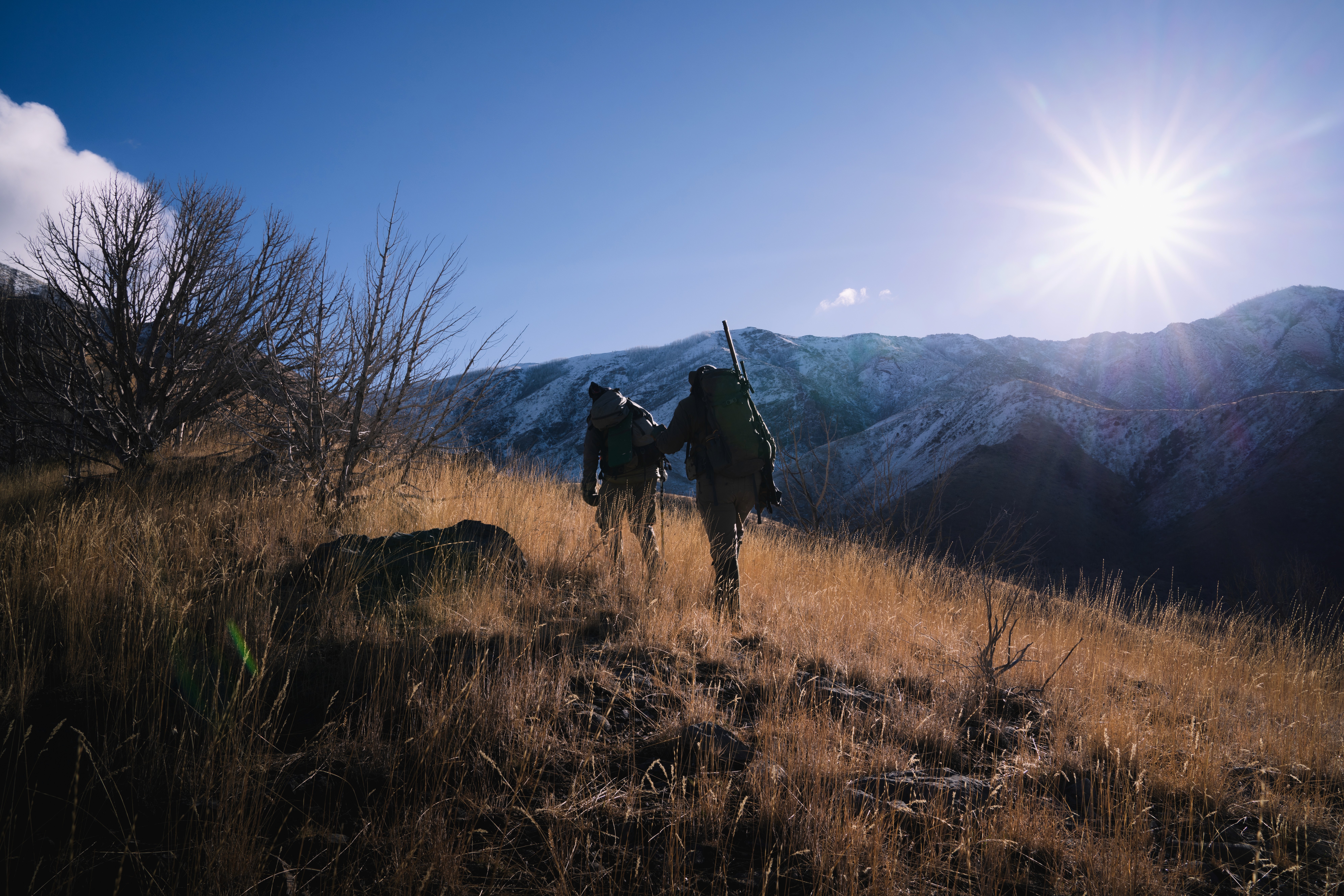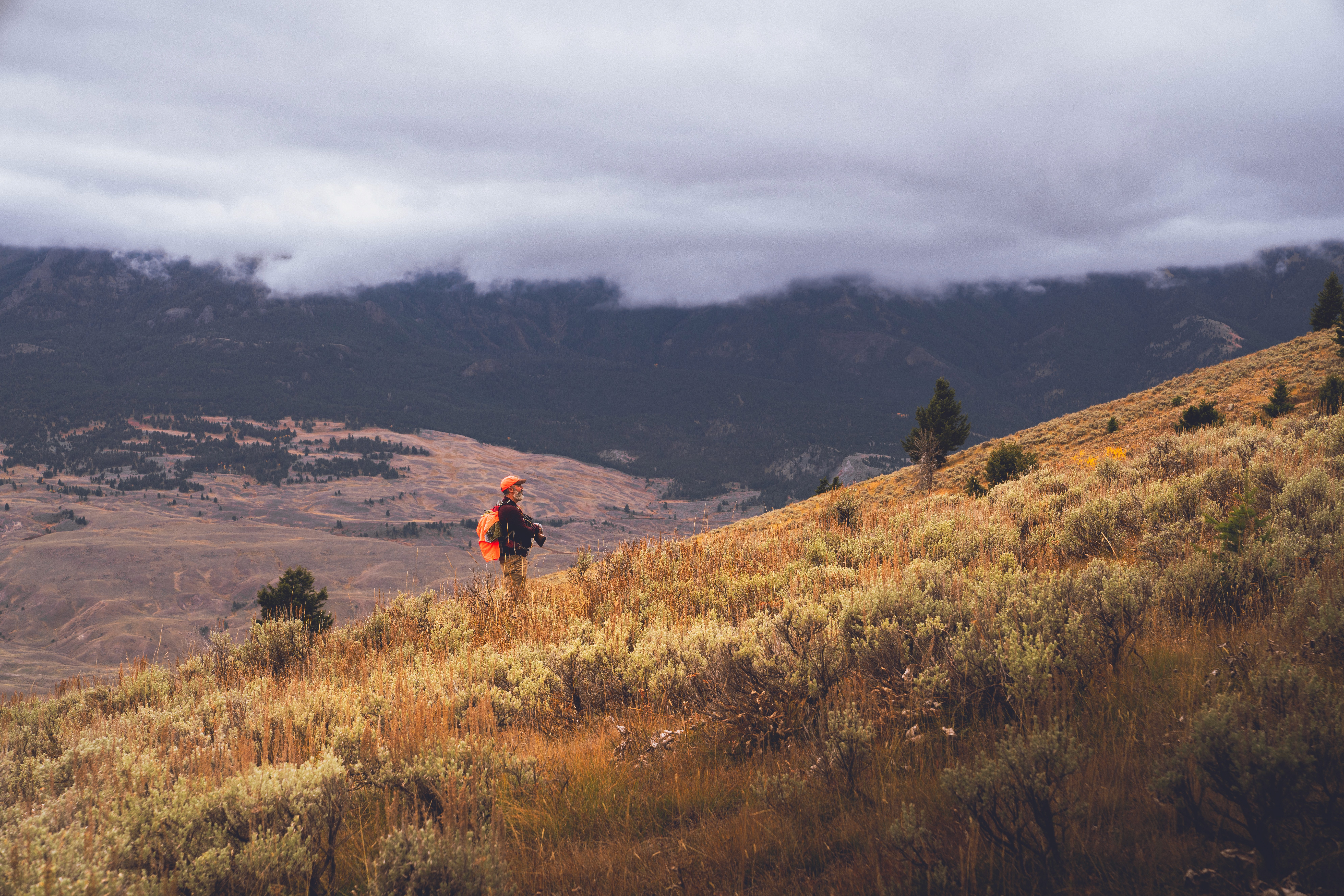



Mountain Hunting
2 Truths About Hunting Fitness Most Hunters Don't Know (But Should)
The title of this article mentions two truths, but really, there are three. There’s a bigger truth that envelopes the two we’ll discuss in this article. It’s the truth that you’ve been led astray by most hunting fitness programs and information. And here’s where it gets upsetting. Because you’ve been led astray by bad training and bad info, you’ve worked hard and not reaped the rewards you should have. We’re going to change that.
A little understanding goes a long way towards improvement because it changes the way you think, the way you act, and in our case, the way you train. When you understand the truth about how to use the gym as a hunter and what conditioning truly is, you stop wasting time with training that doesn’t sustainably work, and you start doing the things that get you results you keep, results that prep you for any hunt you want to go on.
Truth # 1 — The Gym is for Building Hunting Fitness Raw Materials
There are certain qualities we need to be physically successful as hunters. These qualities are the raw materials that we shape into mountain readiness and hunting fitness.
They are:
Movement Capacity / Mobility
Relative Strength
Strength Endurance
Muscular Endurance
Efficiency Under Load
Aerobic Capacity
Aerobic Power
In the gym, we focus mostly on the top three. Yes, we can develop the others in the gym. But the gym is the best place to improve mobility, strength, and strength endurance.
There are a couple problems that hunters face with common hunting strength training. First, it’s not actually strength training. It’s really strength exercises built into some kind of HIIT conditioning circuit that doesn’t truly build strength. Second, there’s too much mimicry of what might happen in the field. These two common problems cause a lot of hunters, well, a lot of problems. It holds them back from building the mobility, relative strength, and strength endurance that translates to hunting fitness.
Moving well saves you energy by making you efficient. It also keeps your joints healthy. You can gain a lot of good movement by doing a solid mobility-based warm-up and sprinkling movement capacity exercises between sets of strength exercises. We do a whole lot of that. But if you’re doing a bunch of “strength” training that’s truly just HIIT with strength exercises built in, then you will train poor movement. The fatigue mounts and you focus on getting through rather than moving well and getting stronger. It creates bad movement habits and teaches your brain to tell your body to move poorly under the context of fatigue. It’s not true strength training for hunters. Just because it recreates a feeling you might have in the mountains, or just because it looks like a way you might move in the mountains, doesn’t mean it’s productive.
Takeaway: Build mobility training into your warm-up, add it between sets of strength exercises, and stop doing HIIT disguised as strength training.
High levels of relative strength also saves you energy. Relative strength is how strong you are relative to your body weight. If you maintain your body weight, or lose some, and improve your strength, every movement you make costs you less energy because it takes place at a lower percentage of your total strength. Think of each step you take uphill with your pack on. The better your relative strength, the less each one of those steps costs you.
You build relative strength with traditional big lifts and appropriate rest periods. Again, HIIT disguised as strength training won’t do it for you because you accrue too much fatigue to use appropriate weights. Strength is also mostly a neurological adaptation — meaning how well your brain and nerves work together to send strong signals to your muscles. You can’t build heavy metabolic fatigue and strengthen those signals at the same time.
Takeaway: Relative strength saves you a ton of energy as a hunter. You build it by using traditional lifting exercises with appropriate rest periods. HIIT disguised as strength training kills your ability to build it.
Strength endurance is your ability to use your strength over time and during repeated efforts. It’s putting your relative strength to good use. And, like relative strength, it’s mostly a neurological adaptation. It is training your nervous system to send strong signals to your muscles over time. Let’s go back to our uphill march example. The better your strength endurance, the better you can use your relative strength to climb higher and farther while staying strong. That means it takes a lot more climbing to make you tired.
You build strength endurance by using enough weight to recruit your fast-twitch muscle fibers and by doing enough work to train your brain and nerves to send strong signals over time. We use two main methods to do that — eustress training and high-intensity continuous training (HICT). These are very dialed-in training methods that ride the line between fatigue and strength in the right way to improve your fitness. They are far different from the random WOD-like HIIT workouts that just make you tired. If you want true strength endurance, the kind that will have your back and your legs in the mountains, then you need to do the right things to build it. Otherwise, you're missing a key raw material.
Takeaway: Strength endurance is your ability to use your strength over time and during repeated efforts. It’s a brain and nervous system adaptation developed by using specific, intelligently-designed training methods. You can’t build it by doing HIIT-like “strength training.”
Now that you’ve learned more about the truth of gym training for hunters, let’s talk about what conditioning truly is.
Truth #2 — Conditioning Teaches the Body to Use Fuel Efficiently
Most hunting conditioning just makes you tired without truly conditioning you to move effectively uphill and downhill over long periods. That’s because most hunting conditioning programs aren’t designed with fueling in mind — they’re just designed to be difficult. But if you understand that conditioning is about fueling efficiency, you’ll see that just doing hard work isn’t enough.
Your body has three energy systems, and two that concern us more than the other.
You have the phosphocreatine system. It’s your fast, powerful system that you utilize during intense efforts that only last a handful of seconds.
You have the glycolytic system. This is the system that burns carbs. It works at varying intensities and durations, kicking in at around the 15-second mark and potentially contributing to energy production for hours.
You have the lipolytic system. This is the system that burns fat. It works at lower intensities and lasts the longest — like, hours and hours.
Here’s the thing, all of your energy systems are active during exercise. It’s just a question of which one is doing the most work based on intensity and duration of the work being done. That said, we want to condition in a way that allows us to rely on our lipolytic system as much as possible while making our glycolytic system super efficient. Here’s all that said in a less nerdy way:
To build endurance for hunting, you need to train your body to rely mostly on fat for fuel while also efficiently burning carbs.
You can’t do that by just doing a bunch of “hard” workouts.
You do it by layering in a smart way and doing the right amounts of each type of conditioning to train your body to efficiently use each type of fuel.
(A quick note on efficiency: it means developing your energy systems so that fuel sources are utilized quickly, but also so you can do more while using less fuel.)
Training your body to efficiently use fat for fuel requires you to do a lot of low-intensity aerobic training. This is your Zone 1 and Zone 2 work. If you want to be in the best possible hunting condition, you can’t skip this work. You start to make meaningful progress at two hours per week. True aerobic development, however, requires three plus hours per week.
Efficient carb training takes place in Zone 3 and Zone 4. Here’s the thing: how you get into Zone 3 and Zone 4 matters a lot. Just doing random hard work to get there won’t make you better conditioned. Doing the right work at the right intensity, and after developing your aerobic system with Zone 1 and Zone 2 work, is what makes Zone 3 and Zone 4 training work for you. Now, here’s the other thing: it doesn’t take nearly as much Zone 3 and Zone 4 training to be conditioned as Zone 1 and Zone 2 training. That’s why it’s so important to have your conditioning planned and balanced in the right way. Otherwise, you don’t truly gain efficiency by utilizing either fuel source.
The result is that your conditioning isn’t what it should be and you have a way harder time in the mountains.
How to Act on the Truths — Putting it Together
Build movement capacity training into every training session.
Cut the HIIT sessions disguised as strength training sessions
Alternate relative strength training and strength endurance training throughout the year.
Spend a few months focused on Zone 1 and Zone 2 training, then start adding in Zone 3 and Zone 4 training.
Know the Truth: Hunting Fitness That Truly Helps You on the Mountain
The gym is for raw materials. Conditioning is to teach your body to efficiently use fuel. These are two of the most important truths of hunting fitness. Now that you understand them, you can cut through a lot of the bullshit you see online, in magazines, and in other training programs. Now, you can Train Smarter and Hunt Longer.
Want to know your current hunting fitness strengths and weaknesses? Download our Free Hunter’s Field Test and know for sure if your strength and your conditioning is where it needs to be.
Recent posts
Related Articles

Fitness Tips
Dec 21, 2025
Honest Efforts: Don't Mail In Meaningful Work
Despite all of this, I think everyone can agree that training involves effort. Zoom out and look at what humans are physically capable of and it's really amazing what sustained effort in any direction leads to. Ballet dancers, endurance athletes, baseball players, F1 drivers - just a few of the many testaments to sustained effort over time. While most of us aren’t trying to be the next Ohtani or Verstappen, we can take one lesson with us - consistent effort drives outcomes.

Fitness Tips
Dec 21, 2025
Honest Efforts: Don't Mail In Meaningful Work
Despite all of this, I think everyone can agree that training involves effort. Zoom out and look at what humans are physically capable of and it's really amazing what sustained effort in any direction leads to. Ballet dancers, endurance athletes, baseball players, F1 drivers - just a few of the many testaments to sustained effort over time. While most of us aren’t trying to be the next Ohtani or Verstappen, we can take one lesson with us - consistent effort drives outcomes.

Fitness Tips
Dec 21, 2025
Honest Efforts: Don't Mail In Meaningful Work
Despite all of this, I think everyone can agree that training involves effort. Zoom out and look at what humans are physically capable of and it's really amazing what sustained effort in any direction leads to. Ballet dancers, endurance athletes, baseball players, F1 drivers - just a few of the many testaments to sustained effort over time. While most of us aren’t trying to be the next Ohtani or Verstappen, we can take one lesson with us - consistent effort drives outcomes.

Mountain Hunting
Dec 15, 2025
How to Test Your Uphill Muscular Endurance for Mountain Hunting
Mountain hunting is a lot of things. It’s an adventure and for many hunters it’s a rite of passage. It’s a challenge of skill, a test of will, and, oftentimes, an experience that at least borders the spiritual. It is also an endeavor that requires a huge amount of muscular endurance. It’s tough to build your uphill muscular endurance to the right levels without knowing where you currently stand and what kind of training will move the needle for you. So, let’s learn you up on how to test your uphill muscle endurance for mountain hunting.

Mountain Hunting
Dec 15, 2025
How to Test Your Uphill Muscular Endurance for Mountain Hunting
Mountain hunting is a lot of things. It’s an adventure and for many hunters it’s a rite of passage. It’s a challenge of skill, a test of will, and, oftentimes, an experience that at least borders the spiritual. It is also an endeavor that requires a huge amount of muscular endurance. It’s tough to build your uphill muscular endurance to the right levels without knowing where you currently stand and what kind of training will move the needle for you. So, let’s learn you up on how to test your uphill muscle endurance for mountain hunting.

Mountain Hunting
Dec 15, 2025
How to Test Your Uphill Muscular Endurance for Mountain Hunting
Mountain hunting is a lot of things. It’s an adventure and for many hunters it’s a rite of passage. It’s a challenge of skill, a test of will, and, oftentimes, an experience that at least borders the spiritual. It is also an endeavor that requires a huge amount of muscular endurance. It’s tough to build your uphill muscular endurance to the right levels without knowing where you currently stand and what kind of training will move the needle for you. So, let’s learn you up on how to test your uphill muscle endurance for mountain hunting.

Mountain Hunting
Dec 10, 2025
The Toughest Hunt on Earth: Himalayan Blue Sheep Expedition
“It’s truly an expedition. I’d even say it’s the purest hunt on earth.” This wasn’t the first time Trey Sperring and I had talked about hunting blue sheep in Nepal. It wasn’t even the second. The first was during our mutual friend and client, John Mark Prewitt’s, California Big Horn hunt in November 2024. Since then, we’ve texted about it, mentioned it on phone calls, and even discussed it during episode 74 of the Packmule Podcast. It is a conversational thread running through our friendship.

Mountain Hunting
Dec 10, 2025
The Toughest Hunt on Earth: Himalayan Blue Sheep Expedition
“It’s truly an expedition. I’d even say it’s the purest hunt on earth.” This wasn’t the first time Trey Sperring and I had talked about hunting blue sheep in Nepal. It wasn’t even the second. The first was during our mutual friend and client, John Mark Prewitt’s, California Big Horn hunt in November 2024. Since then, we’ve texted about it, mentioned it on phone calls, and even discussed it during episode 74 of the Packmule Podcast. It is a conversational thread running through our friendship.

Mountain Hunting
Dec 10, 2025
The Toughest Hunt on Earth: Himalayan Blue Sheep Expedition
“It’s truly an expedition. I’d even say it’s the purest hunt on earth.” This wasn’t the first time Trey Sperring and I had talked about hunting blue sheep in Nepal. It wasn’t even the second. The first was during our mutual friend and client, John Mark Prewitt’s, California Big Horn hunt in November 2024. Since then, we’ve texted about it, mentioned it on phone calls, and even discussed it during episode 74 of the Packmule Podcast. It is a conversational thread running through our friendship.

Fitness Tips
Dec 21, 2025
Honest Efforts: Don't Mail In Meaningful Work
Despite all of this, I think everyone can agree that training involves effort. Zoom out and look at what humans are physically capable of and it's really amazing what sustained effort in any direction leads to. Ballet dancers, endurance athletes, baseball players, F1 drivers - just a few of the many testaments to sustained effort over time. While most of us aren’t trying to be the next Ohtani or Verstappen, we can take one lesson with us - consistent effort drives outcomes.

Mountain Hunting
Dec 15, 2025
How to Test Your Uphill Muscular Endurance for Mountain Hunting
Mountain hunting is a lot of things. It’s an adventure and for many hunters it’s a rite of passage. It’s a challenge of skill, a test of will, and, oftentimes, an experience that at least borders the spiritual. It is also an endeavor that requires a huge amount of muscular endurance. It’s tough to build your uphill muscular endurance to the right levels without knowing where you currently stand and what kind of training will move the needle for you. So, let’s learn you up on how to test your uphill muscle endurance for mountain hunting.


